In the world of culinary delights, the pairing of wine and charcuterie is a testament to the timeless adage that some things are simply meant to be together. This duo has risen from a traditional European staple to a global phenomenon, celebrated for its ability to transform ordinary gatherings into occasions of sophistication and enjoyment. The art of selecting the perfect wine to complement the rich, savory flavors of charcuterie is not just about taste—it’s about creating moments that linger in the memory, enhanced by the elegance and joy of shared experiences.
The Popularity and Elegance of Wine and Charcuterie Boards
The allure of wine and charcuterie boards lies in their simplicity and the depth of pleasure they offer. A well-crafted board brims with textures, colors, and flavors, each component carefully chosen to create a harmonious blend. The popularity of these boards has soared, becoming a centerpiece for social gatherings, intimate dinners, and celebratory occasions. They speak to a desire for elegance and quality, inviting us to savor the moment and delight in the company of others. The beauty of these pairings is not just in the taste but in the experience—the ritual of assembling, the anticipation of the first bite and sip, and the conversation that flows as freely as the wine.
The Science and Sensuality Behind the Pairing
At the heart of this perfect pairing is a dance between science and sensuality. Wine and charcuterie come together in a celebration of balance and contrast. The fatty richness of cured meats finds its counterpart in the acidity or tannic structure of a well-chosen wine, while the complexity of aged cheeses is elevated by the nuanced bouquet of their liquid companion. This interplay is not arbitrary; it’s rooted in the science of taste and the physiology of flavor perception. Yet, beyond the science, there’s an undeniable sensuality—a pleasure derived from the textures, aromas, and flavors that engage all our senses, inviting us to explore and enjoy with abandon
Refine Your Hosting Skills
Embracing the art of wine and charcuterie pairing is an invitation to elevate your hosting to an art form. It’s an opportunity to curate experiences that enchant and delight, to transform meals into memories. This guide is not just a collection of pairings but a passport to a world of culinary exploration, where each selection is a reflection of personal taste and the joy of discovery. Whether you’re a seasoned connoisseur or a curious novice, the journey into wine and charcuterie pairing is one of endless possibilities and pleasures. It’s a chance to refine your palate, to experiment with new combinations, and to share the fruits of your exploration with friends and family. So, raise your glass and ready your board—it’s time to craft the perfect wine and charcuterie experience.

Laying the Foundation: Understanding Wine and Charcuterie
Embarking on the journey to master the art of pairing wine with charcuterie begins with a foundation of understanding and appreciation. This is not merely about indulging in the delectable symphony of flavors; it’s about delving into the essence of each element, unraveling the intricate layers that make wine and charcuterie an unmatched duo in the culinary world. Let us guide you through the essentials, laying the groundwork for crafting experiences that resonate with sophistication and delight.
A Tapestry of Wines: Exploring Varietals and Their Essence
The world of wine is vast and varied, a palette of colors, aromas, and flavors waiting to be explored. From the robust, velvety reds to the crisp, refreshing whites, and the playful sparkles of rosés and champagnes, each varietal brings its own character to the table. Understanding these characteristics is crucial in creating pairings that elevate the experience.
A full-bodied Cabernet Sauvignon, with its rich tannins, marries beautifully with the bold flavors of aged cheeses and cured meats, while the zesty acidity of a Sauvignon Blanc cuts through the fat, offering a refreshing counterpoint to creamier textures. This exploration is not just about the wines themselves but about discovering how they interact with flavors, enhancing and being enhanced in turn
Charcuterie: A World of Flavor Beyond Meats and Cheeses
Charcuterie, in its essence, is the celebration of preservation and flavor. Beyond the commonly envisioned meats and cheeses lies a realm of possibilities—pâtés, terrines, sausages, and more, each with its own texture, fat content, and spice profile. The artistry in charcuterie lies in its variety; the delicate silkiness of prosciutto, the robust spice of chorizo, and the earthy depth of a fine pâté. When paired with the right wine, these elements transcend their individuality, creating a mosaic of taste and sensation that is greater than the sum of its parts.
The Symphony of Texture, Fat, Salt, and Spice
At the heart of an unforgettable wine and charcuterie pairing is the balance of texture, fat, salt, and spice. These components act as the threads that weave the experience together, each playing a pivotal role in the overall harmony. Texture contrasts, such as the crispness of a cracker against the softness of brie, add depth and dimension. The richness of fat in charcuterie is cut by the acidity or tannins in wine, creating a balance that tantalizes the palate. Salt, a flavor enhancer, when paired with the subtle sweetness of certain wines, can elevate the fruit notes, while spice adds a layer of complexity, inviting the wine to respond with its own nuances
Crafting the perfect wine and charcuterie experience is akin to composing a piece of music, where each note and chord has its place, contributing to a greater harmony. By understanding the foundations of wine and charcuterie, one embarks on a journey of sensory exploration, where each pairing is not just a meal but an occasion, an experience to be savored and remembered.
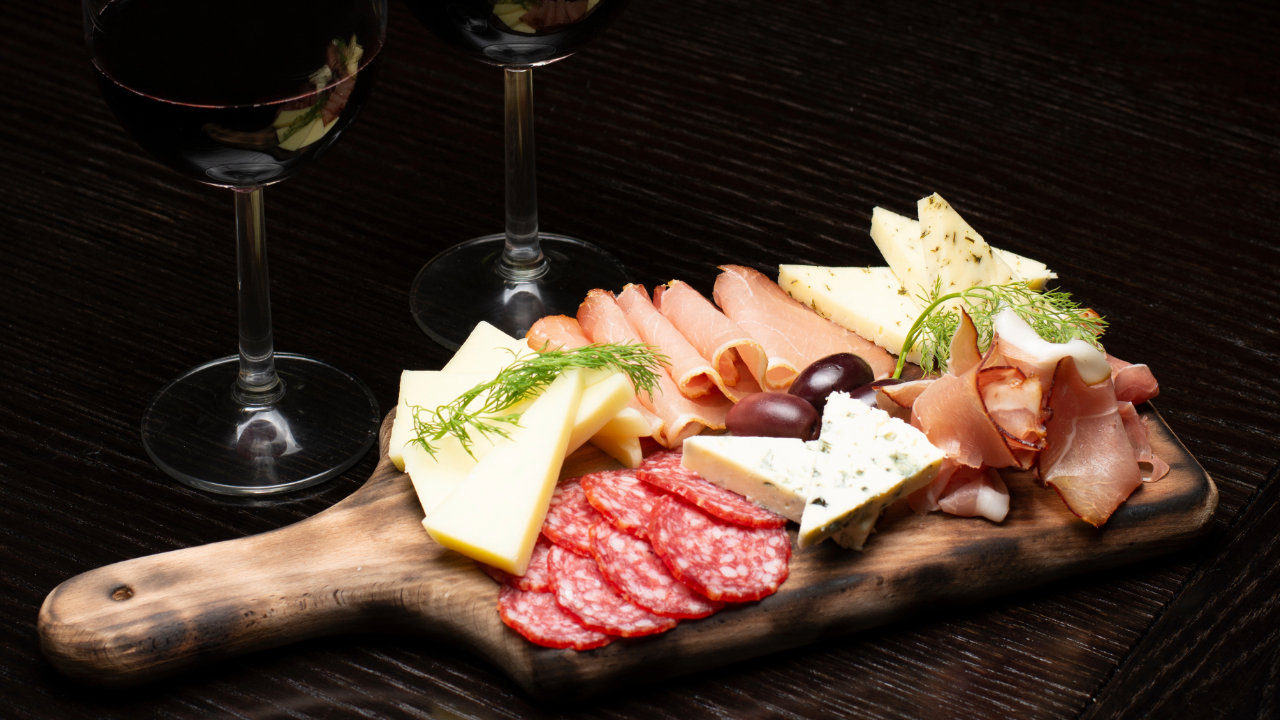
Selecting Your Canvas: Choosing the Right Cheeses
In the realm of crafting an exquisite wine and charcuterie experience, the selection of cheeses serves as the canvas upon which your culinary masterpiece will unfold. The art of cheese pairing is not just about taste; it’s about creating moments, memories, and a dance of flavors that linger on the palate. Let’s delve into the diverse world of cheeses, exploring the myriad of varieties and the art of pairing them with the perfect wine, elevating your hosting to an art form celebrated with each bite and sip.
The Spectrum of Cheeses: A World to Explore
The cheese universe is vast and varied, each type offering a unique texture, flavor, and aroma that can complement or contrast with your chosen wines in delightful ways. From the creamy, delicate freshness of mozzarella to the bold, piquant notes of a mature blue cheese, the spectrum is wide and inviting.
Fresh Cheeses:
Think of fresh cheeses as the tender whispers of the cheese world, soft and mild. These cheeses, including varieties like ricotta, feta, and chevre, offer a subtle canvas that pairs beautifully with light-bodied wines, such as a crisp Pinot Grigio or a sparkling Prosecco, accentuating their freshness.
Soft-ripened Cheeses
With their creamy cores and bloomy rinds, soft-ripened cheeses like Brie and Camembert invite a silky dialogue with slightly more complex wines. A Chardonnay or a light-bodied Pinot Noir can mirror the creamy texture and rich flavors, creating a harmonious blend of taste and sensation.
Semi-hard Cheeses
Semi-hard Cheeses: The versatility of semi-hard cheeses, such as Gouda and Cheddar, makes them a joy to pair. Their firm texture and deeper flavors dance well with a range of wines, from the fruity notes of a Merlot to the oak-infused whispers of an aged Chardonnay.
Aged Cheeses
The depth and intensity of aged cheeses, like Parmigiano-Reggiano and aged Gouda, demand wines that can stand up to their boldness. Full-bodied reds, such as Cabernet Sauvignon or a robust Zinfandel, can match their rich flavors and complexity.
Blue Cheeses
The assertive, spicy, and somewhat salty nature of blue cheeses, like Gorgonzola or Roquefort, pairs exquisitely with the sweetness of dessert wines, such as Sauternes or Port, creating a balance that is both bold and beautiful.
Pairing Principles: Harmony and Contrast
The key to successful cheese and wine pairing lies in the balance of matching and contrasting flavors and textures. Consider the intensity of both the cheese and the wine, seeking either to complement or boldly contrast the flavors, ensuring one does not overpower the other but rather elevates the pairing to an experience of indulgence and discovery.
Expert Tips for Presentation and Enjoyment
To fully appreciate the nuanced flavors of your cheese selection, allow them to come to room temperature before serving, unlocking their full aroma and taste profiles. When it comes to presentation, embrace the artistry of cutting cheeses, from the elegant wedges of soft-ripened cheeses to the rustic chunks of aged varieties, each shape inviting a different tactile and taste experience.
Selecting the right cheeses for your wine and charcuterie experience is an adventure, a journey through textures, flavors, and aromas that culminate in an orchestration of culinary delight. With each pairing, you craft not just a meal, but a memory, an exploration of the senses that invites conversation, laughter, and a deeper appreciation for the simple, yet profound, pleasures of wine and cheese.
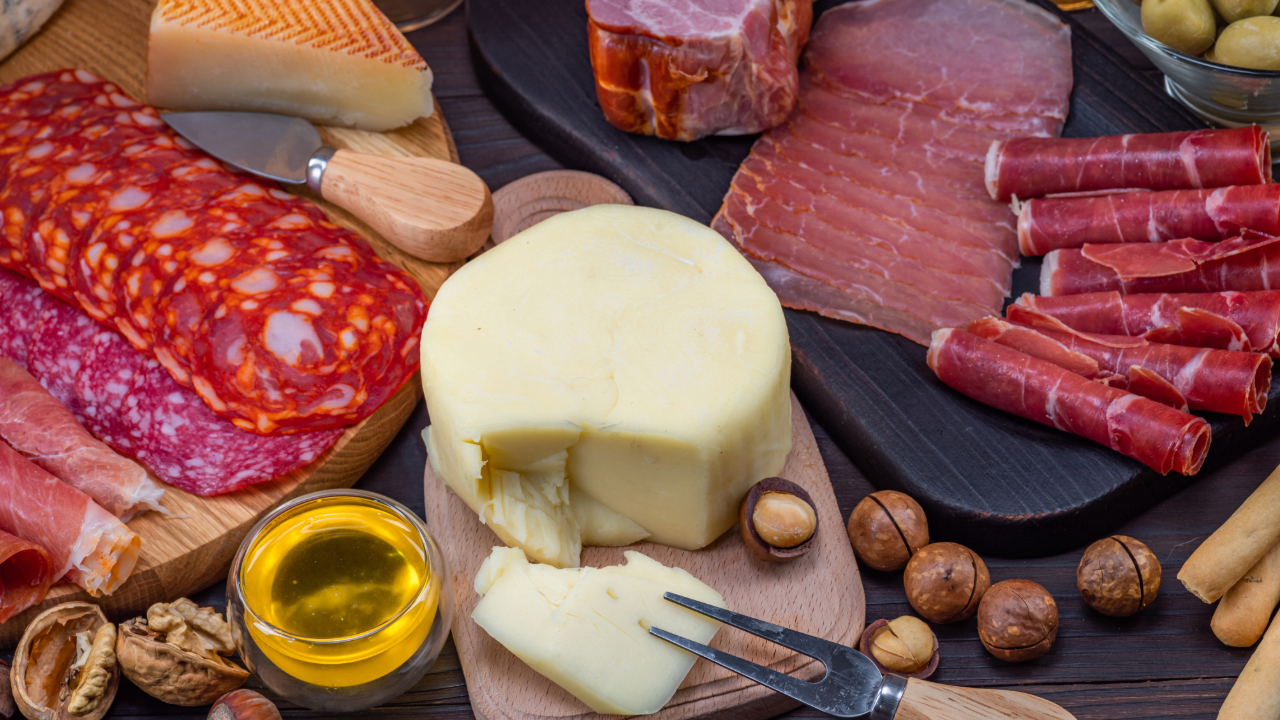
The Art of Meat – Curating Your Charcuterie
Embarking on the journey of curating your charcuterie for the perfect wine pairing experience is akin to painting with flavors, where each stroke adds depth and character to your canvas. This exploration is not merely about selecting meats; it’s an art form, a dialogue between the palate and the plate, where the essence of each selection is harmonized with the perfect sip of wine. Let’s delve into the nuanced world of charcuterie, navigating through the spectrum of flavors from the delicate to the daring, and discover how to masterfully pair these selections with wines that elevate the entire tasting experience.
Exploring the Charcuterie Spectrum: A Palette of Flavors
Charcuterie offers a delightful array of options, from the subtle, tender whispers of prosciutto to the bold, robust choruses of chorizo. Each type of charcuterie brings its unique texture, flavor, and aroma to the table, inviting an exploration of sensory delights.
Mild Flavors
Begin your charcuterie journey with the mild, delicate flavors of meats like prosciutto or capocollo. These selections whisper softly to the palate, pairing beautifully with light-bodied wines such as a crisp Sauvignon Blanc or a sparkling Champagne, enhancing their gentle, nuanced flavors.
Medium Flavors
As we venture further, the medium-flavored charcuterie such as salami or mortadella offers a balanced, more pronounced taste. These selections create a harmonious pairing with medium-bodied wines, such as a rich Chardonnay or a fruity Pinot Noir, bridging the gap between subtlety and boldness.
Bold Flavors
For those who dare to delve into the intense, bold flavors, charcuterie like chorizo or soppressata stands ready to challenge and delight. These powerfully flavored meats pair exquisitely with full-bodied wines, such as a robust Cabernet Sauvignon or a spicy Syrah, matching their intensity and complexity.
Pairing Charcuterie with Wines: Finding Harmony in Intensity
The secret to a successful charcuterie and wine pairing lies in the balance of flavors and intensities. Aim to match the weight of the charcuterie with the body of the wine, allowing each to complement the other without overwhelming the senses. Consider the saltiness, fat content, and spice level of the charcuterie, and seek wines that either offer a refreshing counterpoint or a harmonious echo to these qualities.
Creative Presentation: A Feast for the Eyes
Beyond taste, the presentation of your charcuterie board plays a crucial role in the overall experience. Employ creative folding and placement techniques to add aesthetic appeal to your arrangement. Fold thinly sliced meats like prosciutto into elegant ribbons or arrange salami into a rosette pattern, adding visual interest and inviting guests to explore the board with their eyes before savoring the flavors. The layout should not only be pleasing to the eye but also functional, allowing easy access to each item on the board.
Curating your charcuterie is an art form that goes beyond mere selection; it’s about creating a symphony of flavors and textures that resonate with the chosen wines, crafting an experience that is as delightful to the palate as it is to the eye. With each pairing, you’re not just serving food and wine; you’re orchestrating an unforgettable journey through the senses, one that invites discovery, appreciation, and, above all, enjoyment.
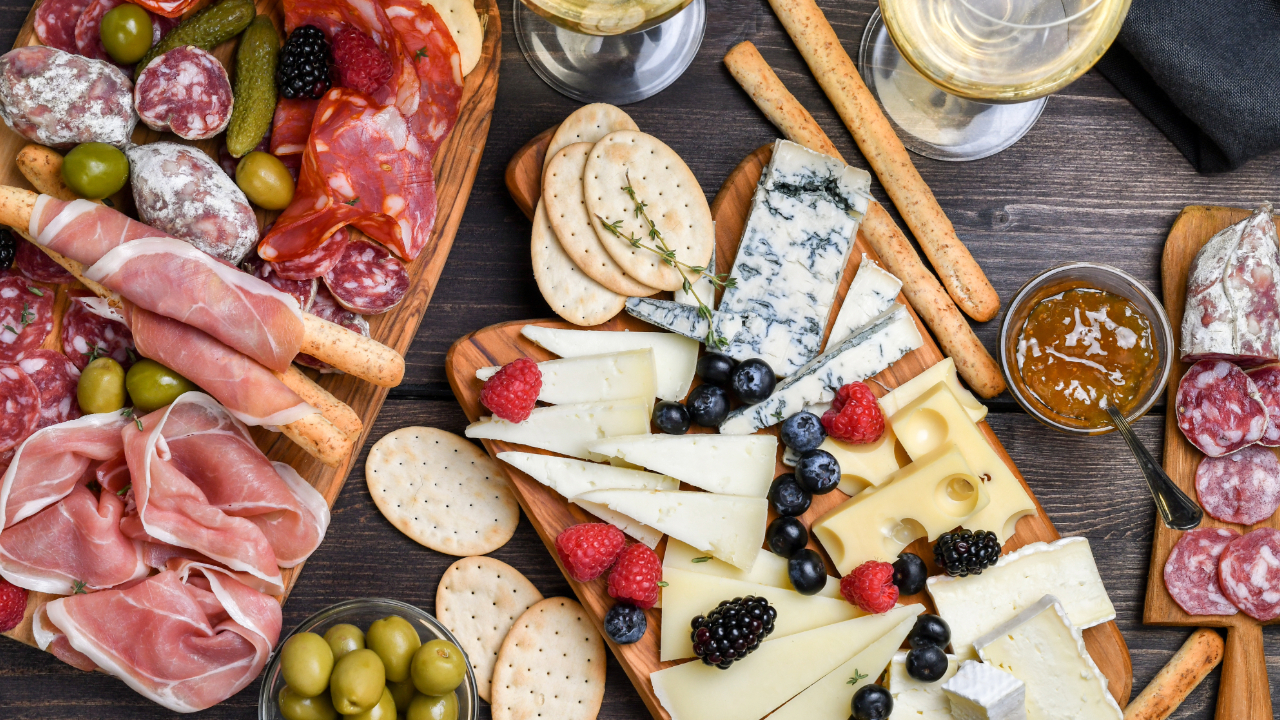
Accents and Enhancements – Olives, Pickles, and More
In the symphony of flavors that compose a wine and charcuterie experience, the accents and enhancements play a pivotal role in elevating the entire composition. It’s within these seemingly minor details—like the zesty tang of pickled vegetables or the briny depth of olives—that the true artistry of a charcuterie board is revealed. These elements add contrast, brightness, and an intricate layering of flavors that can transform your pairing from delightful to unforgettable.
The Role of Pickled Vegetables and Olives: A Study in Contrast
Imagine the crisp, acidic snap of a pickled green bean cutting through the richness of a creamy cheese, or the way a briny olive can enhance the fruity depth of a full-bodied wine. These are not just accompaniments; they are essential players that bring balance, cutting through fat and richness to cleanse the palate and ready it for the next sumptuous bite. The diversity in pickled vegetables and olives allows for endless exploration, from the sharp bite of cornichons to the subtle sweetness of pickled carrots or the complex flavors of mixed olive assortments.
Pairing Suggestions: Harmony in Acidity and Crunch
When considering pairings, the goal is to balance the board’s overall flavor profile. The acidity of pickled vegetables can be a refreshing counterpoint to both the saltiness of charcuterie and the robustness of aged cheeses. Similarly, olives can range from mildly sweet to intensely salty, offering a versatile palette to complement or contrast with your wine selections. For instance, a crisp Sauvignon Blanc might pair beautifully with the tanginess of pickled radishes, while a bold Syrah could be the perfect counterpart to the richness of oil-cured black olives.
Ideas for Pickles and Olives: The Homemade and the Curated
While store-bought pickles and olives provide convenience and a wide range of options, there’s a special charm in adding homemade pickles to your board. Simple to prepare and infinitely customizable, homemade pickles can be tailored to suit your specific flavor preferences and the nuances of your wine selections. Whether you’re quick-pickling vegetables overnight for a fresh crunch or curating a selection of artisanal olives from a local market, these elements allow you to inject personal flair and creativity into your board
Consider incorporating a mix of textures and flavors—garlicky dill pickles, spicy pickled peppers, and sweetly brined pearl onions, alongside a selection of green, black, and Kalamata olives. Each choice adds a new dimension, inviting guests to explore and find their perfect bite.
The art of crafting the perfect wine and charcuterie experience is much like painting a masterpiece; it’s the subtle shades and textures that bring the canvas to life. Accents like olives and pickled vegetables are the brushstrokes that add depth, contrast, and vibrancy, transforming your charcuterie board into a captivating display of culinary artistry. Through thoughtful selection and pairing, these enhancements not only complement the primary elements but also stand out in their own right, creating a harmonious and unforgettable experience for all who gather around your table.

Sweet and Savory Symphony – Fruits and Nuts
In the orchestration of a sublime wine and charcuterie experience, the interlude of fruits and nuts plays a pivotal role, akin to a sweet and savory symphony that harmonizes with the core elements of wines and cured meats. This chapter delves into the delicate balance between sweet and salty, offering a guide to enriching your board with the nuanced flavors of fruits and nuts, enhancing the overall sensory pleasure of your pairing adventure.
The Balance of Sweet and Salty: Incorporating Fruits and Nuts
Fruits and nuts, with their diverse textures and flavors, introduce an additional layer of complexity and delight to the wine and charcuterie narrative. The juxtaposition of the salty richness of meats and the creamy depth of cheeses against the sweet crispness or lush softness of fruits, alongside the crunchy, earthy notes of nuts, creates a tapestry of taste that is both intricate and inviting. This section will explore how the right fruit and nut pairings can elevate the wine and charcuterie experience, transforming it into an ensemble of flavors that sings in perfect harmony.
Seasonal Pairing Suggestions for Fresh and Dried Fruits
Seasonality plays a key role in selecting fruits that will not only complement your charcuterie board but also enhance the wines you’ve chosen to spotlight. Fresh fruits, in their peak season, offer a burst of natural sweetness and acidity that can cut through the richness of meats and cheeses, providing a refreshing counterpoint. Dried fruits, on the other hand, offer a concentrated sweetness and chewy texture that pairs beautifully with both soft and hard cheeses, as well as robust and delicately flavored wines. This section will guide you through selecting the best seasonal fruits, both fresh and dried, to match the profile of your wines and the character of your charcuterie, ensuring that each pairing is a celebration of flavor and season.
Selecting Nuts: From Toasted to Candied Varieties
Nuts add a dimension of texture and a whisper of earthiness that can complement or contrast the flavors on your board. From the rich, buttery profiles of macadamias and cashews to the robust, slightly bitter notes of walnuts and almonds, nuts are versatile accompaniments that can be tailored to your wine and charcuterie selections.
Toasting nuts can amplify their natural flavors, adding a warm depth that pairs wonderfully with aged cheeses and fuller-bodied wines.
Candied nuts, with their sweet coating, offer a delightful crunch and a hint of sweetness that can brighten the palate, especially when served alongside sparkling wines or fruity, lighter reds. This section will offer insights into selecting and preparing nuts in ways that enhance their natural qualities while complementing the other components of your charcuterie board.
Through the thoughtful integration of fruits and nuts, your wine and charcuterie experience becomes a more comprehensive sensory journey, one that weaves together the sweet with the savory, the crunchy with the creamy, creating a symphony of flavors that is both nuanced and memorable. This chapter aims to inspire you to explore the endless possibilities that fruits and nuts can bring to your table, encouraging a creative and harmonious approach to pairing that celebrates the diversity of textures and tastes in the world of wine and charcuterie.
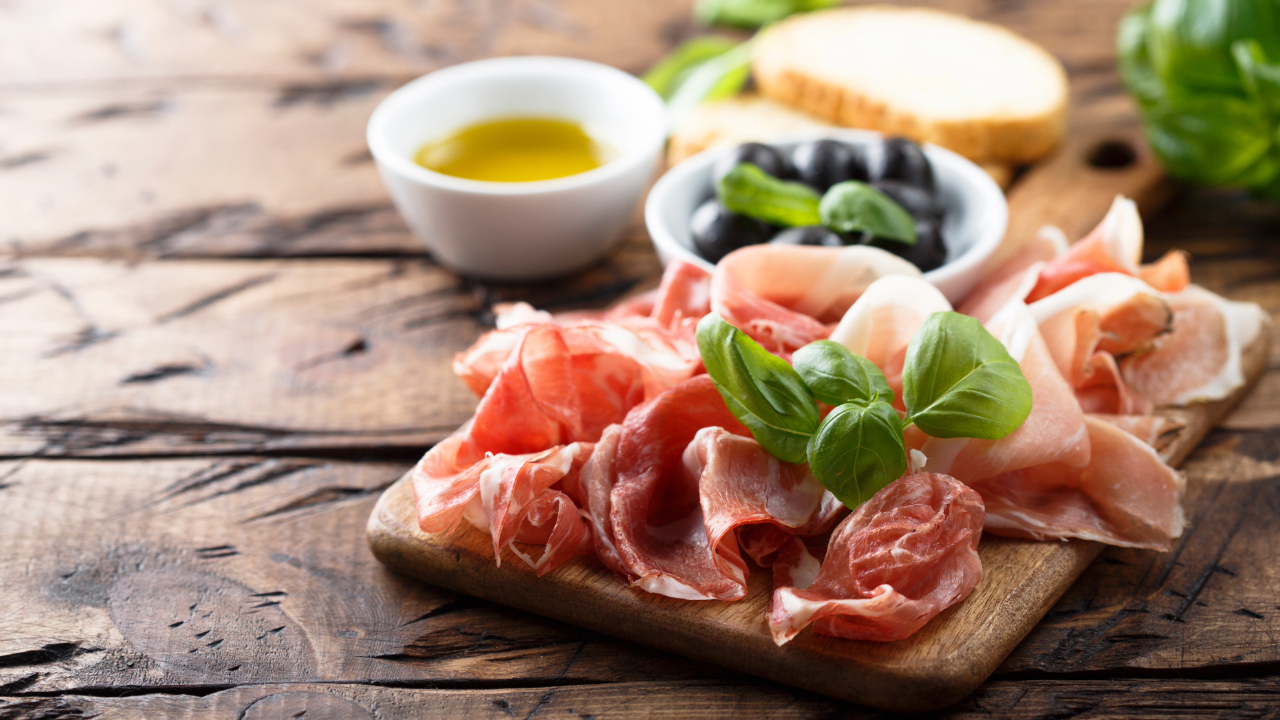
The Final Touches – Oils, Spreads, and Breads
In the grand finale of assembling a wine and charcuterie masterpiece, the nuanced details of oils, spreads, and breads emerge as the silent yet impactful conductors of flavor, texture, and overall gastronomic harmony. This chapter is dedicated to these final touches, the subtle brushstrokes that complete the picture, elevating the experience from simply delightful to truly memorable.
Enhancing Flavors with Olive Oils, Fruit Jams, and Artisanal Spreads
The drizzle of a robust olive oil, the sweet allure of fruit jams, and the rich complexity of artisanal spreads can transform your charcuterie board into a canvas of endless flavor possibilities. Olive oils, with their varied tasting notes, from peppery to fruity, introduce a velvety texture and a depth of flavor that can enhance both the meats and the cheeses. Fruit jams, with their sweet and sometimes tart profiles, act as a bridge between the savory elements and the wines, offering a counterbalance that highlights the unique characteristics of each pairing. Artisanal spreads, whether savory or sweet, add a layer of sophistication and intrigue, inviting guests to explore combinations that tantalize the palate and stimulate the senses. This section will guide you through selecting and pairing these enhancements, ensuring that each addition complements and elevates the overall experience.
Bread Selection: Complementing Textures and Flavors with Your Charcuterie Board
Bread serves as the foundation upon which many of the board’s elements are enjoyed, its texture and flavor integral to the pairing experience. The choice between a crusty baguette, a soft focaccia, or a dense pumpernickel can influence the interplay of flavors and textures, offering a backdrop that either contrasts or harmonizes with the components of your board. This selection process is guided by the principle of balance, seeking breads that complement without overpowering, that support without dominating. This section will explore how to select breads that enhance the charcuterie and wine selections, providing practical tips on pairing bread textures and flavors with the delicate balance of your board’s offerings.
Gluten-Free and Alternative Options for Inclusive Hosting
Inclusive hosting ensures that every guest can indulge in the joy of a wine and charcuterie experience, regardless of dietary restrictions or preferences. Offering gluten-free and alternative options is a thoughtful touch that makes the experience accessible to all. From gluten-free crackers and breads to vegetable-based crisps and other creative substitutes, this section will present a variety of options that do not compromise on flavor or texture. By incorporating these alternatives, hosts can create a welcoming and inclusive environment, ensuring that every guest can partake in the delight of discovery and the pleasure of pairing.
The journey through oils, spreads, and breads, like the final strokes of a masterpiece, is one of refinement and attention to detail. It’s about enhancing and complementing, about creating a symphony of flavors and textures that resonate with every guest. This chapter aims to inspire hosts to consider these final touches not as mere additions, but as essential elements that complete the wine and charcuterie experience, making it a memorable exploration of taste, texture, and the art of pairing.

Composition and Presentation – Assembling Your Masterpiece
In the realm of culinary arts, the final act of creation is not just about taste but equally about presentation. Assembling your wine and charcuterie board is akin to painting a masterpiece, where each element plays a crucial role in the overall experience. This chapter is dedicated to guiding you through the nuances of composition and presentation, ensuring that your board is not only a feast for the palate but also a feast for the eyes, setting the stage for an unforgettable soirée.
Step-by-Step Guide to Arranging Your Board: Layout, Design Principles, and Garnishing
The journey to a visually stunning board begins with understanding the principles of layout and design. Think of your board as a blank canvas, awaiting the delicate balance of color, texture, and form. Start with your largest items, such as cheese blocks and charcuterie, placing them strategically to create focal points. Intersperse with smaller items, filling spaces with olives, nuts, and fruits, to add color and contrast. Consider the flow, encouraging guests to explore flavors through thoughtful placement that invites curiosity and interaction.
Garnishing plays a pivotal role in elevating the aesthetic appeal. Fresh herbs, edible flowers, and a drizzle of honey or balsamic glaze can transform your board from simple to spectacular, adding layers of texture and bursts of color that entice the senses.
The Importance of Visual Appeal in Elevating the Tasting Experience
Visual appeal is not merely about beauty; it’s a precursor to the tasting experience. A well-composed board tempts the eyes, priming the palate and setting expectations for the flavors to come. It speaks to the care and thoughtfulness invested in the selection and arrangement of each element, enhancing the overall sensory experience. This section delves into how visual appeal acts as an essential ingredient in the alchemy of taste, creating a harmonious interplay between sight and flavor that elevates the experience from ordinary to extraordinary.
Hosting Tips: Setting the Scene for Your Wine and Charcuterie Soirée
The ambiance of your soirée is the backdrop against which your wine and charcuterie masterpiece is showcased. Lighting, music, and table setting all contribute to the mood, creating an environment that complements the sensory journey of your board. Soft lighting and ambient music can set a relaxed tone, while elegant tableware and thoughtful seating arrangements invite guests to indulge in the shared experience of discovery and enjoyment.
Consider personal touches that reflect your style and the occasion, from handwritten labels that tell the story of each wine and cheese to unique serving pieces that add character and charm. These hosting tips are designed to inspire, helping you create a setting that is not just a backdrop but an integral part of the wine and charcuterie experience, making your soirée an event to remember.
In crafting the perfect wine and charcuterie experience, composition and presentation are as vital as the flavors themselves. This chapter aims to equip you with the knowledge and inspiration to assemble a board that captivates the senses, setting the stage for an evening of elegance, exploration, and enjoyment.
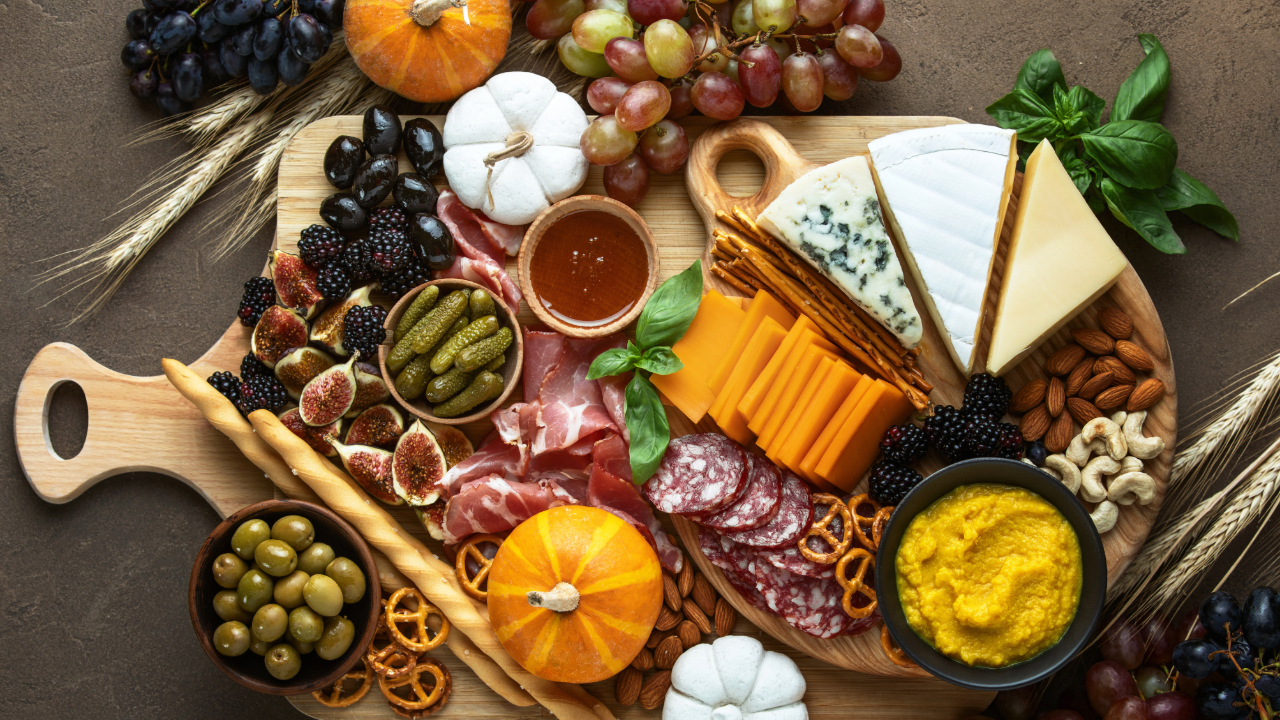
Advanced Pairing Strategies – Elevating Your Board
Venturing into the realm of advanced pairing strategies is akin to embarking on a gastronomic journey that elevates your wine and charcuterie board from a mere culinary delight to an exquisite exploration of flavors, textures, and aromas. This chapter is devoted to guiding aficionados through the sophisticated layers of pairing, ensuring that each sip and bite is not just consumed but experienced, resonating with a refined palate.
Beyond the Basics: Exploring Unique Wine Varietals and Rare Charcuterie
Delve into the world beyond well-trodden paths by introducing your palate to the lesser-known, yet equally captivating, wine varietals and rare charcuterie selections. Discover wines that challenge the conventional, from the minerally whites of the Loire Valley to the bold, undiscovered reds of lesser-known regions, each offering a unique narrative of the terroir they hail from. Pair these with charcuterie that speaks of artisanal craftsmanship and heritage, such as aged, hand-crafted salamis or exotic, air-dried meats from remote corners of the globe. This exploration not only tantalizes the taste buds but also enriches the understanding and appreciation of the diversity in wine and charcuterie production.
Thematic Boards: Creating Pairings Based on Regions, Seasons, or Occasions
Elevate your hosting by curating thematic boards that resonate with the essence of regions, seasons, or specific occasions. Imagine a board that transports your guests to the rolling hills of Tuscany with a selection of Chianti paired with pecorino and finocchiona or one that celebrates the bounty of autumn with harvest wines and accompaniments that echo the season’s flavors. Thematic boards are not just about pairing; they are about storytelling, creating an immersive experience that engages and delights all senses.
Pairing Wines with High Tannins and Avoiding Common Pitfalls
The challenge of pairing wines with high tannins is one that, when navigated skillfully, can lead to remarkably harmonious combinations. The key lies in understanding the interaction between tannins and fat, where the richness of select charcuterie can soften the astringency of tannins, revealing the underlying complexity of the wine. This section offers insight into selecting the right types of charcuterie that complement high-tannin wines, such as aged cheeses and richly flavored meats, and shares expert tips to avoid common pitfalls that can overshadow the pairing experience.
Advanced pairing strategies are about pushing boundaries and exploring the depths of flavor and harmony. This chapter invites you on a journey to refine your palate, enhance your appreciation, and elevate your wine and charcuterie boards into a symphony of sophisticated tastes and textures. It’s an invitation to transcend the ordinary, embracing the art and science of pairing to create experiences that linger long after the last bite is savored and the final sip is taken.
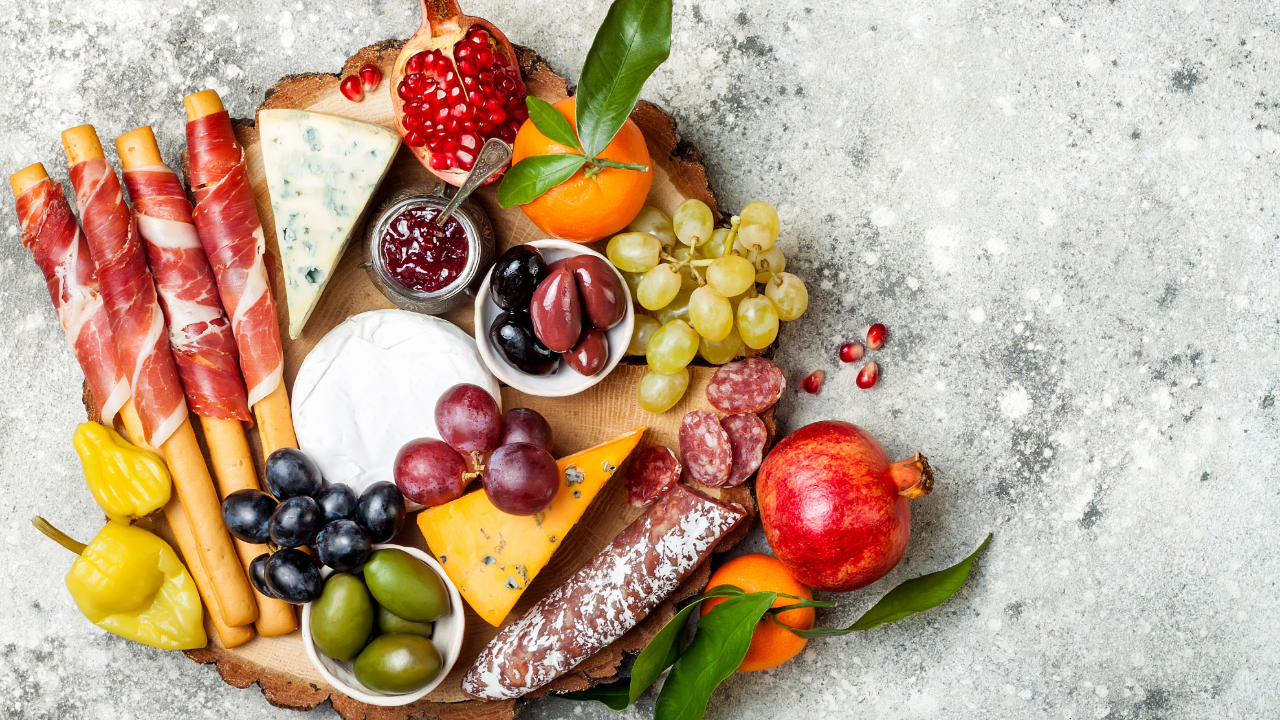
Signature Pairing Ideas – Inspired Creations
As we journey through the art of crafting the perfect wine and charcuterie experience, we arrive at a chapter brimming with inspiration and creativity, designed to cater to every palate and preference. Signature pairing ideas are the essence of personal expression in the culinary realm, where each selection and combination tells a story, evokes an emotion, or transports you to a distant land. Here, we explore three distinct themes that promise to inspire your next gathering, each with its unique character and suggested wine pairings.
The Plant-Based Platter: A Vegetarian’s Delight with Wine Suggestions
Embrace the bounty of the earth with a plant-based platter that defies the conventional and celebrates the richness of vegetarian fare. This platter is a tapestry of textures and flavors, featuring artisanal vegan cheeses made from nuts, an array of roasted and fresh vegetables, and vegan charcuterie selections such as mushroom pâté and lentil terrines. Accompany these with wines that complement the freshness and vibrancy of the ingredients—think crisp Sauvignon Blanc, light-bodied Pinot Noir, or a sparkling Prosecco. This pairing is a testament to the versatility of wine and the endless possibilities of plant-based cuisine, offering a refreshing and inclusive option for all guests.
The Carnivore’s Feast: A Bold, Meat-Heavy Board with Robust Wines
For those with a penchant for the rich and savory, the Carnivore’s Feast is a celebration of meat in all its glory. This board is laden with a selection of cured meats, from spicy chorizo and salami to succulent prosciutto and bresaola, each offering its own depth of flavor and texture. To stand up to these bold tastes, select wines with robust profiles—full-bodied Cabernet Sauvignon, smoky Syrah, or a rich Zinfandel. These wines not only complement the intensity of the meats but also cut through the fat, cleansing the palate and preparing it for the next indulgent bite. This pairing is a bold statement, perfect for those who revel in the decadence of meat and wine.
The Mediterranean Mosaic: Flavors of the Coast Paired with Refreshing Wines
Transport your guests to the sun-drenched shores of the Mediterranean with a board that captures the essence of coastal cuisine. This mosaic of flavors includes a variety of seafood charcuterie, such as smoked salmon, anchovies, and octopus, alongside olives, hummus, and sun-dried tomatoes. The wines chosen to accompany these seaside delights are as refreshing as a gentle sea breeze—crisp Vermentino, floral Viognier, or a chilled Rosé. Each sip offers a harmonious complement to the salty, briny flavors of the board, creating a pairing that sings of summer days and balmy nights by the sea.
Signature pairing ideas invite you to explore the limitless possibilities of wine and charcuterie, encouraging you to experiment, personalize, and ultimately delight in the creation of inspired boards that reflect your taste and style. Whether you lean towards the plant-based, revel in the richness of meat, or yearn for the flavors of the Mediterranean, these pairing ideas serve as a starting point for your own culinary adventures, promising memorable experiences with every glass raised and every plate shared.

Beyond the Board – The Experience of Sharing
In the gentle closing of our journey through the crafting of the perfect wine and charcuterie experience, we find ourselves not at an end, but at a beginning. Beyond the meticulously arranged boards and carefully selected wines lies the true essence of this endeavor: the joy of sharing. Wine and charcuterie, in their rich diversity and complexity, serve not merely as sustenance but as a profound medium for connection and celebration. They bring us together, sparking conversations, laughter, and memories that linger long after the last glass is emptied.
As we lift our glasses in a toast to the artistry of pairing, let us also celebrate the spirit of experimentation and discovery. The path to finding your own perfect pairings is as unique as your palate, filled with endless possibilities and opportunities to explore. There is no right or wrong here, only the journey of taste, guided by curiosity and a willingness to venture beyond the familiar. Each bottle opened, each slice savored, adds a new layer to your understanding and appreciation of these timeless pleasures.
We extend an invitation to deepen this exploration, to step beyond the confines of your dining room and into the wider world of wine and charcuterie. Visit local wineries, where the passion of the winemakers and the stories behind each vineyard add depth to every sip. Seek out artisanal delis, where the craft of charcuterie is alive in the flavors of hand-crafted meats and cheeses. These experiences enrich not only your palate but your understanding of the traditions and craftsmanship that shape the wine and charcuterie landscape.
In sharing these experiences, we share more than just food and drink; we share stories, traditions, and a piece of ourselves. The wine and charcuterie board becomes a canvas, not just for flavors, but for the expression of hospitality, friendship, and the simple joy of being together. So, as we conclude, remember that the true beauty of wine and charcuterie lies not just in the pairing, but in the sharing. May your boards always be bountiful, your glasses never empty, and your gatherings filled with the warmth of good company.
